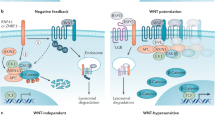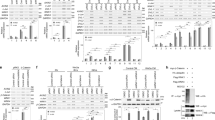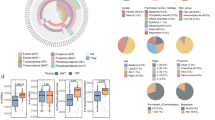Abstract
Wilms tumours (WTs) have two distinct types of histology with or without ectopic mesenchymal elements, suggesting that WTs arise from either the mesenchymal or epithelial nephrogenic lineages. Regardless of the presence or absence of CTNNB1 mutations, nuclear accumulation of β-catenin is often observed in WTs with ectopic mesenchymal elements. Here, we addressed the relationship between the WNT-signalling pathway and lineage in WTs by examining CTNNB1 and WT1 mutations, nuclear accumulation of β-catenin, tumour histology and gene expression profiles. In addition, we screened for mutations in WTX, which has been proposed to be a negative regulator of the canonical WNT-signalling pathway. Unsupervised clustering analysis identified two classes of tumours: mesenchymal lineage WNT-dependent tumours, and epithelial lineage WNT-independent tumours. In contrast to the mesenchymal lineage specificity of CTNNB1 mutations, WTX mutations were surprisingly observed in both lineages. WTX-mutant WTs with ectopic mesenchymal elements had nuclear accumulation of β-catenin, upregulation of WNT target genes and an association with CTNNB1 mutations in exon 7 or 8. However, epithelial lineage WTs with WTX mutations had no indications of active WNT signalling, suggesting that the involvement of WTX in the WNT-signalling pathway may be lineage dependent, and that WTX may have an alternative function to its role in the canonical WNT-signalling pathway.
This is a preview of subscription content, access via your institution
Access options
Subscribe to this journal
Receive 50 print issues and online access
$259.00 per year
only $5.18 per issue
Buy this article
- Purchase on SpringerLink
- Instant access to full article PDF
Prices may be subject to local taxes which are calculated during checkout







Similar content being viewed by others
References
Barberi T, Willis LM, Socci ND, Studer L . (2005). Derivation of multipotent mesenchymal precursors from human embryonic stem cells. PLoS Med 2: e161.
Barker N, van Es JH, Kuipers J, Kujala P, van den Born M, Cozijnsen M et al. (2007). Identification of stem cells in small intestine and colon by marker gene Lgr5. Nature 449: 1003–1007.
Beachy PA, Karhadkar SS, Berman DM . (2004). Tissue repair and stem cell renewal in carcinogenesis. Nature 432: 324–331.
Beckwith JB . (1998). Nephrogenic rests and the pathogenesis of Wilms tumor: developmental and clinical considerations. Am J Med Genet 79: 268–273.
Beckwith JB, Kiviat NB, Bonadio JF . (1990). Nephrogenic rests, nephroblastomatosis, and the pathogenesis of Wilms' tumor. Pediatr Pathol 10: 1–36.
Boccaccio C, Comoglio PM . (2006). Invasive growth: a MET-driven genetic programme for cancer and stem cells. Nat Rev Cancer 6: 637–645.
Breslow NE, Beckwith JB, Perlman EJ, Reeve AE . (2006). Age distributions, birth weights, nephrogenic rests, and heterogeneity in the pathogenesis of Wilms tumor. Pediatr Blood Cancer 47: 260–267.
Bunting KD . (2002). ABC transporters as phenotypic markers and functional regulators of stem cells. Stem Cells 20: 11–20.
Clevers H . (2006). Wnt/beta-catenin signaling in development and disease. Cell 127: 469–480.
Eberhart CG, Argani P . (2001). Wnt signaling in human development: beta-catenin nuclear translocation in fetal lung, kidney, placenta, capillaries, adrenal, and cartilage. Pediatr Dev Pathol 4: 351–357.
Eisen MB, Spellman PT, Brown PO, Botstein D . (1998). Cluster analysis and display of genome-wide expression patterns. Proc Natl Acad Sci USA 95: 14863–14868.
Etheridge SL, Spencer GJ, Heath DJ, Genever PG . (2004). Expression profiling and functional analysis of wnt signaling mechanisms in mesenchymal stem cells. Stem Cells 22: 849–860.
Fodde R . (2003). The multiple functions of tumour suppressors: it's all in APC. Nat Cell Biol 5: 190–192.
Fukuzawa R, Heathcott RW, Sano M, Morison IM, Yun K, Reeve AE . (2004a). Myogenesis in Wilms' tumors is associated with mutations of the WT1 gene and activation of Bcl-2 and the Wnt signaling pathway. Pediatr Dev Pathol 7: 125–137.
Fukuzawa R, Breslow NE, Morison IM, Dwyer P, Kusafuka T, Kobayashi Y et al. (2004b). Epigenetic differences between Wilms' tumours in white and east-Asian children. Lancet 363: 446–451.
Fukuzawa R, Heathcott RW, More HE, Reeve AE . (2007). Sequential WT1 and CTNNB1 mutations and alterations of beta-catenin localisation in intralobar nephrogenic rests and associated Wilms tumours: two case studies. J Clin Pathol 60: 1013–1016.
Fukuzawa R, Anaka MR, Heathcott RW, McNoe LA, Morison IM, Perlman EJ et al. (2008). Wilms tumour histology is determined by distinct types of precursor lesions and not epigenetic changes. J Pathol 215: 377–387.
Grohmann A, Tanneberger K, Alzner A, Schneikert J, Behrens J . (2007). AMER1 regulates the distribution of the tumor suppressor APC between microtubules and the plasma membrane. J Cell Sci 120: 3738–3747.
Irizarry RA, Bolstad BM, Collin F, Cope LM, Hobbs B, Speed TP . (2003). Summaries of Affymetrix GeneChip probe level data. Nucleic Acids Res 31: e15.
Jenkins ZA, Kogelenberg M, Morgan T, Jeffs A, Fukuzawa R, Pearl E et al. Germline mutations in the tumour suppressor WTX cause a sclerosing bone dysplasia but do not predispose to tumorigenesis. Nat Genet (in press).
Koesters R, Niggli F, von Knebel Doeberitz M, Stallmach T . (2003). Nuclear accumulation of beta-catenin protein in Wilms' tumours. J Pathol 199: 68–76.
Koesters R, Ridder R, Kopp-Schneider A, Betts D, Adams V, Niggli F et al. (1999). Mutational activation of the beta-catenin proto-oncogene is a common event in the development of Wilms' tumors. Cancer Res 59: 3880–3882.
Li CM, Kim CE, Margolin AA, Guo M, Zhu J, Mason JM et al. (2004). CTNNB1 mutations and overexpression of Wnt/beta-catenin target genes in WT1-mutant Wilms' tumors. Am J Pathol 165: 1943–1953.
Lindsley RC, Gill JG, Kyba M, Murphy TL, Murphy KM . (2006). Canonical Wnt signaling is required for development of embryonic stem cell-derived mesoderm. Development 133: 3787–3796.
Maiti S, Alam R, Amos CI, Huff V . (2000). Frequent association of beta-catenin and WT1 mutations in Wilms tumors. Cancer Res 60: 6288–6292.
Major MB, Camp ND, Berndt JD, Yi X, Goldenberg SJ, Hubbert C et al. (2007). Wilms tumor suppressor WTX negatively regulates WNT/beta-catenin signaling. Science 316: 1043–1046.
Mishra L, Derynck R, Mishra B . (2005). Transforming growth factor-beta signaling in stem cells and cancer. Science 310: 68–71.
Morison IM, Becroft DM, Taniguchi T, Woods CG, Reeve AE . (1996). Somatic overgrowth associated with overexpression of insulin-like growth factor II. Nat Med 2: 311–316.
Ogawa O, Eccles MR, Szeto J, McNoe LA, Yun K, Maw MA et al. (1993). Relaxation of insulin-like growth factor II gene imprinting implicated in Wilms' tumour. Nature 362: 749–751.
Pardal R, Clarke MF, Morrison SJ . (2003). Applying the principles of stem-cell biology to cancer. Nat Rev Cancer 3: 895–902.
Perotti D, Gamba B, Sardella M, Spreafico F, Terenziani M, Collini P et al. (2008). Functional inactivation of the WTX gene is not a frequent event in Wilms' tumors. Oncogene 27: 4625–4632.
Ridgeway AG, Skerjanc IS . (2001). Pax3 is essential for skeletal myogenesis and the expression of Six1 and Eya2. J Biol Chem 276: 19033–19039.
Rivera MN, Kim WJ, Wells J, Driscoll DR, Brannigan BW, Han M et al. (2007). An X chromosome gene, WTX, is commonly inactivated in Wilms tumor. Science 315: 642–645.
Ruteshouser EC, Robinson SM, Huff V . (2008). Wilms tumor genetics: mutations in WT1, WTX, and CTNNB1 account for only about one-third of tumors. Genes Chromosomes Cancer 47: 461–470.
Schouten JP, McElgunn CJ, Waaijer R, Zwijnenburg D, Diepvens F, Pals G . (2002). Relative quantification of 40 nucleic acid sequences by multiplex ligation-dependent probe amplification. Nucleic Acids Res 30: e57.
Smyth GK . (2004). Linear models and empirical Bayes methods for assessing differential expression in microarray experiments. Stat Appl Genet Mol Biol 3: Article3.
Wang Y, Belflower RM, Dong YF, Schwarz EM, O'Keefe RJ, Drissi H . (2005). Runx1/AML1/Cbfa2 mediates onset of mesenchymal cell differentiation toward chondrogenesis. J Bone Miner Res 20: 1624–1636.
Zavadil J, Bottinger EP . (2005). TGF-beta and epithelial-to-mesenchymal transitions. Oncogene 24: 5764–5774.
Zirn B, Samans B, Wittmann S, Pietsch T, Leuschner I, Graf N et al. (2006). Target genes of the WNT/beta-catenin pathway in Wilms tumors. Genes Chromosomes Cancer 45: 565–574.
Acknowledgements
This study was supported by the Health Research Council of New Zealand.
Author information
Authors and Affiliations
Corresponding author
Additional information
Declaration
The authors have no conflict of interests.
Supplementary Information accompanies the paper on the Oncogene website (http://www.nature.com/onc)
Rights and permissions
About this article
Cite this article
Fukuzawa, R., Anaka, M., Weeks, R. et al. Canonical WNT signalling determines lineage specificity in Wilms tumour. Oncogene 28, 1063–1075 (2009). https://doi.org/10.1038/onc.2008.455
Received:
Revised:
Accepted:
Published:
Issue date:
DOI: https://doi.org/10.1038/onc.2008.455
Keywords
This article is cited by
-
Hallmark discoveries in the biology of Wilms tumour
Nature Reviews Urology (2024)
-
Wilms tumor in patients with osteopathia striata with cranial sclerosis
European Journal of Human Genetics (2021)
-
Pygo2 functions as a prognostic factor for glioma due to its up-regulation of H3K4me3 and promotion of MLL1/MLL2 complex recruitment
Scientific Reports (2016)
-
Analyzing the gene expression profile of anaplastic histology Wilms’ tumor with real-time polymerase chain reaction arrays
Cancer Cell International (2015)
-
Temporal blastemal cell gene expression analysis in the kidney reveals new Wnt and related signaling pathway genes to be essential for Wilms' tumor onset
Cell Death & Disease (2011)



